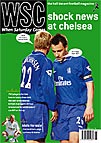 Football’s best images are those which are integral to the game, believes Ian Plenderleith who finds artistic celebration but also pointless commercial exploitation in this month’s internet review
Football’s best images are those which are integral to the game, believes Ian Plenderleith who finds artistic celebration but also pointless commercial exploitation in this month’s internet review
Football’s lords and masters forever fret about the image of the game, forgetting it has been making its own images for over a hundred years and needs no help from the charlatans behind misguided marketing strategies. This month’s guide takes you to some of the best and worst places online to forage around for football’s colourful heritage.
Classic Kits is a retrospective treasure trove of yesterday’s colours and a simple, virtually text-free depiction of English club kits over the past century or so. Although the site admits to having lifted much of its content from Bob Bickerton’s book Club Colours, it is nonetheless a useful resource for settling that eternal staple of football pedants – the pointless and trivial dispute over historical minutiae. And it continues to be both backdated and updated.
A perusal of various club colours may, however, raise more questions than it answers. Why did Leyton Orient go all Croatian in 1998? Is there any width of red stripe that Brentford have not yet tried on their shirts? Why are Coventry the only side that have experimented with both all-brown and all-black strips? What drugs were the Bolton kit designers on in the 1890s, when they followed a pink shirt with polka-dot red on white? And is it a coincidence that Manchester City used to win trophies back in the 1960s when they had red in their shirts?
You can take a different kind of journey into the past at The Homes of Football, Stuart Clarke’s sister website to the museum of the same name in the Lake District town of Ambleside. Although the site only contains a fraction of the 65,000 images archived by the museum, it still boasts an impressive pictorial map of the British game. The quality and range of the pictures are superb and worth the wait of the less than lightning download times.
Photographs of Albion Rovers attacking a ten-man Queens Park defence on a grey Scottish afternoon, or shell-suited fans at an Aldershot v Burnley evening match in 1991, capture as much about the game and its history as any long-worded tome. Soaked supporters at Barrow v Accrington Stanley; the ramshackle practice pitch at Craigmark Burtonians; a sign at Keswick FC imploring people: “Please avoid driving across the football pitch”; and a row of denim-wearing Glasgow Rangers fans as they practise synchronised pissing in public outside Hampden Park: all these delights and more await the curious surfer.
I was more sceptical about logging on to Jazzarenas, the site of football mosaics artist Jeff Challenor, especially when the first image on the “welcome” page was of Gianfranco Zola apparently disfigured by third-degree facial burns. But when the artist sticks to team logos, as he has done for Middlesbrough and the FA, or on his poignant Hillsborough memorial mosaic, his work is far more distinguished.
It’s certainly several steps up from the myriad sites offering overpriced sketches and snapshots of legends, sometimes framed and autographed, and several steps removed from the artistry of either the players themselves or even their hard-nailed counterparts in the bowels of the football league pyramid. Check out the “Soccer” section at Pencil Classics for an unlikely representation of George Best, David Beckham doing what looks like an Eric Cantona impersonation and several Nottingham Forest worthies seemingly in the throes of a collective primal scream (though it’s true there’s a lot of that kind of thing in the east midlands). Thank the gods of art that these editions have been limited.
If cash-strapped (or thirsty) ex-pros such as Best, Denis Law and Geoff Hurst want to sign pictures of themselves and flog them at ridiculous prices (bigbluetube.com) then presumably market demand will deem the schemes successful or not.
Not that there’s anything wrong with the pictures themselves. I just can’t stand having artefacts thrust under my nose by a febrile fan expecting me to drool and rave because some over-idolised star of yesterday spent half a second defacing it with an indecipherable squiggle of black felt tip. The game’s enduring images are far more likely to be found in the metal of the floodlight supports taken from a skewed angle on a cloud-pocked afternoon.
From WSC 198 August 2003. What was happening this month